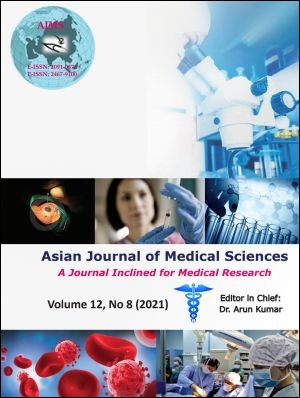A Study on Serum Nitric Oxide and Hydrogen Sulfide in Essential Hypertension Cases in a Tertiary Care Hospital in West Bengal
Keywords:
Nitric oxide, Hydrogen sulfide, Essential hypertension, Kolkata, West BengalAbstract
Background-Essential hypertension is a multifactorial disease of unknown etiology characterized by a chronic elevation of blood pressure without any secondary causes. Nitric oxide and hydrogen sulfide are vasodilatory gasotransmitters whose deficiency results in endothelial dysfunction and vasoconstriction and hence is one of the etiological factors in the development of hypertension.
Aims and Objectives – The study aimed to estimate the serum levels of NO and H₂S and to find out their correlation in essential hypertension cases and normotensive controls.
Materials and Methods- Serum levels of NO and H₂S were measured using chemical methods, in fifty patients with essential hypertension and compared with fifty age-matched controls.
Results- The mean serum NOx level in essential hypertension cases is 45.45 ± 11.09 µmol/L which is significantly lower (p-value <0.001) than that of controls where it is 166.40 ± 16.63 µmol / L. The mean serum H₂S level in essential hypertension cases is 45.61 ± 11.01 µmol/ L which is again significantly lower ( p-value <0.001) than controls in which it is 111.54 ± 9.60 µmol/ L. A statistically significant positive correlation exists between serum NOx and H₂S levels in overall study subjects.
Conclusion- This study demonstrates that both the serum levels of NO and H₂S decrease with an increase in BP in essential hypertension cases. There exists a positive correlation between NO and H₂S in overall study subjects. Thus, the simultaneous decline in bioavailability of both NO and H₂S is a significant underlying cause in the development of essential hypertension.
Downloads
Downloads
Published
How to Cite
Issue
Section
License
Copyright (c) 2021 Asian Journal of Medical Sciences

This work is licensed under a Creative Commons Attribution-NonCommercial 4.0 International License.
Authors who publish with this journal agree to the following terms:
- The journal holds copyright and publishes the work under a Creative Commons CC-BY-NC license that permits use, distribution and reprduction in any medium, provided the original work is properly cited and is not used for commercial purposes. The journal should be recognised as the original publisher of this work.
- Authors are able to enter into separate, additional contractual arrangements for the non-exclusive distribution of the journal's published version of the work (e.g., post it to an institutional repository or publish it in a book), with an acknowledgement of its initial publication in this journal.
- Authors are permitted and encouraged to post their work online (e.g., in institutional repositories or on their website) prior to and during the submission process, as it can lead to productive exchanges, as well as earlier and greater citation of published work (See The Effect of Open Access).




